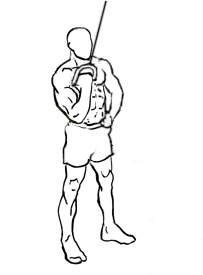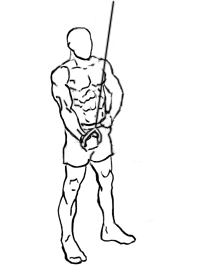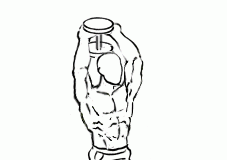Last Updated on December 18, 2023
The One Arm Tricep Extension with Cable is a staple in any well-rounded arm workout. This single-arm exercise effectively isolates each tricep, helping to balance strength and muscle development in both arms. While it may seem simple, focusing on technique is crucial to get the best results and avoid strain or injury.
Here’s everything you need to know to master the One Arm Tricep Extension with Cable:
Benefits of One Arm Tricep Extension with Cable
- Muscle Isolation: This exercise targets each tricep individually, which is essential for fixing muscle imbalances and ensuring each arm develops equally.
- Improved Definition: By focusing on triceps in isolation, this movement helps define the back of the arm.
- Functional Strength: Strong triceps are essential for movements involving arm extension, from lifting objects overhead to performing push-ups.
- Joint Stability: Strengthening the triceps supports the elbow joint, reducing the risk of injury in the elbow and surrounding muscles.
- Enhances Symmetry: Training each arm separately ensures your arms develop in symmetry, especially helpful if you have a dominant arm.
Anatomy of the Triceps
Before diving into the exercise, understanding the tricep muscles is helpful. The triceps brachii, often just called the triceps, is a three-headed muscle at the back of your arm. Here are the three parts:
- Long Head: Runs along the back of your arm and is crucial for stability and power in overhead movements.
- Lateral Head: Located on the outer side of the arm, responsible for the “horseshoe” shape of the triceps.
- Medial Head: Found below the long and lateral heads, this part aids in stability and assists with lower-intensity movements.
Each head of the triceps is activated during the One Arm Tricep Extension with Cable, making this exercise ideal for balanced tricep development.
Step-by-Step Guide: One Arm Tricep Extension with Cable
- Setting Up: Position a cable pulley at the highest setting and attach a single stirrup handle to the pulley. Ensure the weight selected is challenging but manageable.
- Grip and Stance:
- Face the weight stack and grab the handle with an underhand grip (palm facing up).
- Stand with feet shoulder-width apart, keeping a slight bend in your knees for stability.
- Keep your back straight, core engaged, and shoulders relaxed.
- Starting Position:
- Begin with your working arm fully bent at the elbow, holding the handle close to your shoulder.
- Keep your elbow tucked close to your body, focusing on keeping it stationary throughout the movement.
- Execution:
- Exhale as you push the handle downward, straightening your arm fully. Focus on feeling the contraction in the tricep.
- Move through the entire range of motion, extending your arm until it’s completely straight.
- Pause briefly at the bottom of the movement, squeezing your tricep to maximize contraction.
- Return:
- Slowly and with control, allow the handle to return to the starting position as you inhale.
- Avoid letting the weight stack hit to maintain constant tension on your tricep.
Common Mistakes to Avoid
- Swinging the Arm: Keep your elbow tucked in and close to your torso to ensure the tricep does the work, not your shoulder or other muscles.
- Using Excessive Weight: Start with a manageable weight to focus on form before progressing.
- Not Fully Extending: Complete the movement fully to engage the entire tricep muscle.
- Letting the Elbow Drift: Keep your elbow stationary for a more effective isolation.
Tips for Optimal Performance
- Maintain Elbow Position: Keeping your elbow locked in place ensures isolation of the tricep, giving you a more effective workout.
- Controlled Movements: Avoid fast or jerky motions. Slow, controlled movements enhance muscle engagement.
- Focus on Breathing: Exhale during the extension phase and inhale during the return phase to help maintain core stability.
- Try Different Angles: Adjusting the pulley height or handle can slightly change the muscle activation, giving you a fresh challenge.
Variations of One Arm Tricep Extension with Cable
Adding variety can help prevent plateaus and continue to challenge your triceps. Here are some variations:
- Reverse Grip Tricep Extension:
- Use an overhand grip instead of an underhand grip. This shifts the focus slightly to engage different tricep fibers.
- Rope Attachment:
- Instead of a single stirrup handle, attach a rope to the cable. This requires more stabilization and can activate the triceps differently.
- Seated One Arm Tricep Extension:
- Perform the exercise seated to reduce the role of stabilizing muscles, further isolating the triceps.
- Kneeling Cable Tricep Extension:
- By kneeling, you eliminate any leg support, forcing your core to stabilize. This setup can increase core engagement as a bonus.
Integrating One Arm Tricep Extension with Cable Into Your Routine
Adding this exercise to your upper body or arm day routine can be highly beneficial. Here’s a sample routine that includes it:
- Warm-Up:
- Light cardio (5-10 minutes) followed by dynamic stretching.
- Include arm circles and shoulder rotations to prepare your shoulders and triceps.
- Workout Routine:
- Close-Grip Bench Press: 4 sets of 10 reps to target the chest and triceps.
- Overhead Dumbbell Extension: 4 sets of 10-12 reps to engage the long head of the triceps.
- One Arm Tricep Extension with Cable: 3 sets of 12-15 reps for each arm to isolate and target triceps.
- Tricep Dips: 3 sets of 12 reps as a compound movement.
- Cable Pushdowns: 4 sets of 10-12 reps to finish off the triceps with a focus on the lateral head.
- Cool Down:
- Stretch the triceps by reaching one arm overhead and pulling on the elbow gently.
- Perform static stretches to relax the muscles and aid recovery.
Adjustments for Different Fitness Levels
- Beginners:
- Use a light weight and focus on perfecting form. It’s crucial to start with a controlled movement to avoid joint strain.
- Aim for 2-3 sets with higher reps (15-20) to develop endurance and form before progressing to heavier weights.
- Intermediate:
- Increase weight slightly and consider doing fewer reps (8-12) for added strength.
- Focus on the pause at the peak of the contraction to maximize tension.
- Advanced:
- Incorporate variations like drop sets or negatives for an extra challenge.
- Try using a rope attachment or adjusting angles to stimulate the triceps differently.
Benefits for Athletes and Weightlifters
For athletes, this exercise is beneficial because strong triceps play a crucial role in upper body power movements, such as throwing, pressing, and other explosive movements.
Incorporating Mind-Muscle Connection
The mind-muscle connection is crucial in isolation exercises like the One Arm Tricep Extension with Cable. Visualize the tricep contracting and extending as you move through each rep. This focus can significantly enhance muscle activation and growth.
Safety Considerations
- Proper Form: Always use a weight you can control. It’s better to maintain proper form with a lighter weight than to compromise with heavier weights.
- Joint Alignment: Ensure that your wrist, elbow, and shoulder remain aligned to prevent strain.
- Avoid Overuse: Limit tricep isolation exercises to 1-2 times a week to allow muscles adequate recovery.
- Warm-Up Thoroughly: Cold muscles are more prone to injury, so a good warm-up is essential.
Recap and Final Tips
The One Arm Tricep Extension with Cable is a fantastic exercise for building defined, balanced triceps. It’s versatile, challenging, and perfect for all fitness levels, whether you’re aiming for endurance, strength, or muscle definition. Remember, practice and consistency are key, and by keeping good form, you’ll see significant gains.
This tricep exercise is effective when done with proper form and care, making it a valuable addition to your upper body workout routine. It complements other compound and isolation exercises, making it a staple for building powerful, well-defined triceps.








